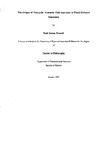The Origin of Polycyclic Aromatic Hydrocarbons in Diesel Exhaust Emissions
| dc.contributor.author | Tancell, Paul James | |
| dc.contributor.other | School of Geography, Earth and Environmental Sciences | en_US |
| dc.date.accessioned | 2013-11-06T13:08:35Z | |
| dc.date.available | 2013-11-06T13:08:35Z | |
| dc.date.issued | 1995 | |
| dc.identifier | NOT AVAILABLE | en_US |
| dc.identifier.uri | http://hdl.handle.net/10026.1/2633 | |
| dc.description.abstract |
Emission limits for diesel engine exhaust pollutants are being continually reduced in line with increasingly stringent emissions legislation. Essential to the task of reducing diesel exhaust emissions is an understanding of the origin of the exhaust pollutants. This research has investigated the origin of a group of compounds, polycyclic aromatic hydrocarbons (PAH), in diesel exhaust emissions using 14C-radiotracer techniques developed specifically to investigate the origin of the organic components in diesel emissions. The use of radiotracers in this research has enabled both the extent to which individual PAH survive combustion and the extent to which PAH are pyrosynthesized during combustion to be measured accurately. No other diesel emissions research technique has yielded information which is so unequivocal. Radio-chromatographic techniques were developed specifically for the identification and quantification of radioactive species present in diesel emissions resulting from the combustion of a single 14C-radiolabelled precursor. Radio-high performance liquid chromatography (radio-HPLC) was the main technique used and was applicable as both a tool for sample fractionation and for analytical measurement. Radio-gas chromatographic techniques (radio-GC) were also developed and applied to the identification of radioactive species in the exhaust emissions. Diesel exhaust samples were collected from a 2L direct injection Perkins Prima diesel engine using a novel exhaust sampling device, the Total Exhaust Solvent Stripping Apparatus (TESSA) devised previously to sample organic species from automobile exhausts. Diesel combustion experiments were performed on three 14C-radiolabelled PAH, fluorene, pyrene and benzo[α]pyrene (B[α]P), and 14C-n-hexadecane. These were spiked into the diesel fuel and were combusted in the Prima Engine. The extent of survival was 0.04% for B[α]P, 0.17% for pyrene and 0.87% for fluorene. The amount of each PAH in the exhaust emissions derived from pyrosynthetic sources ranged from <20% for B[α]P, to 26.5% for fluorene and 71% for pyrene. The extent to which individual PAH survive the diesel combustion process was correlated with the molecular orbital distribution of the molecule, and especially the energy levels of the lowest unoccupied molecular orbital (LUMO). It is concluded that the relationship between PAH survival and PAH molecular orbitals (MOs) is owing to the kinetics of combustion reactions and the chemical reactivity of the P AH. The extent to which individual PAH molecules are formed during combustion varies considerably. From the limited number of experiments performed in the current research it has not been possible to determine the mechanisms responsible for the formation of these PAH during combustion. Mass balance calculations have demonstrated that the degree of pyrosynthesis of the parent PAH molecules investigated in this research may be accounted for by comparatively low rates of dealkylation of alkyl-substituted derivatives present in diesel fuel. The importance of dealkylation reactions during diesel combustion, was investigated by combusting a low aromatic fuel spiked with a non-radiolabelled alkyl-PAH, 2- and 3-ethylphenanthrene (2- and 3-EtPa), which were synthesized for this purpose. The 2 and 3-EtPa isomers were recovered in yields of 0.35% and 0.3% respectively. No dealkylation of the EtPa was detected. A statistically significant increase in the emissions of 3-methylphenanthrene (3-MePa) was detected and was equivalent to a conversion rate of 0.0004% of the EtPa spike. It is proposed that the ease with which individual alkyl-PAH isomers are dealkylated varies for specific isomers, and is dependent on the position of the alkyl-substituent on the aromatic nucleus. The major product from the combustion of the EtPa was vinylphenanthrene (ViPa) which produced in a yield equivalent to a conversion of 0.01% of the EtPa spike. Radiotracer experiments with 14C-n-hexadecane were performed to investigate the origin of the aliphatic component of diesel emissions. The extent of hexadecane survival was 0.35%. Approximately two thirds of the hexadecane in the emissions was derived from pyrosynthetic sources. The most probable source of the pyrosynthesized hexadecane in the emissions was 'thermal cracking of higher molecular weight aliphatic species in diesel fuel during the combustion process. This process may account for a significant proportion of lower molecular weight n-alkanes emitted in diesel emissions. | en_US |
| dc.language.iso | en | en_US |
| dc.publisher | University of Plymouth | en_US |
| dc.title | The Origin of Polycyclic Aromatic Hydrocarbons in Diesel Exhaust Emissions | en_US |
| dc.type | Thesis | |
| plymouth.version | Full version: final and full version as approved by the examiners at the time of the award of your degree | en_US |
| dc.identifier.doi | http://dx.doi.org/10.24382/4326 | |
| dc.identifier.doi | http://dx.doi.org/10.24382/4326 |
Files in this item
This item appears in the following Collection(s)
-
01 Research Theses Main Collection
Research Theses Main


